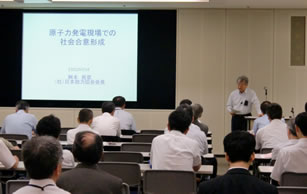Day Two (July 14, 2010)
[A-2] Nondestructive Evaluation (NDE)
[B-1] Poster Session and Shotgun Presentation
[B-2] Maintenance Optimization
[C-1] Pipe Wall Thinning – its Management and Measurement
[C-2] Prototype Fast Breeder Reactor (FBR) Monju
[E-1] Maintenance Sociology (Part I "Community Relations")
[E-2] International Session
[E-3] Industry-academic Collaboration (Part I) - Needs and Case Studies
[F-3] EJAM Session
[E-1] Maintenance Sociology (Part I "Community Relations")
With so many restrictions for the sites, there are big gaps among the field, the government, and the public. For personnel working in the field, it is important to communicate with the ordinary people including the locals in the language which is comprehensible to them.
- E-1-1
- Making of Social Consensus in the Field of Nuclear Power Station
Abstract
Every thing begins from the fields of nuclear power stations and ends there. The working people in the field are the key persons to get community's confidence against nuclear power generation. In order to make the social consensus between the local community and nuclear power station, staffs of power station should do efforts daily, in open way and provide easily understandable information continuously to the community. What should be informed? These are occurred events in the nuclear power station, efforts to operate the power station safely, occurred events in other power stations, and especially events possibly reported in tomorrow's news papers. Communication approach is also discussed in this presentation.
Keywords
Nuclear Power Station, Field, Social Consensus, Community, Confidence, Information
- E-1-2
- The proposal towards the new stage between the relationship of nuclear safety and a local Government
Abstract
My proposal is to take the environmental radiation monitoring currently carried out by local Government, and accountability of the regulatory agency, into regulatory Law. The purpose of this proposal is to clarify the role of radiation monitoring which is related both safety and relief.
Keywords
proposal, environmental radiation monitoring, regulatory Law, local Government, regulatory agency, accountability
- E-1-3
- Unstated knowledge required in the communication for describing safety of nuclear power plant
Abstract
The discussions in the committee for investigation of the integrity and safety of the Kashiwazaki-Kariwa nuclear power plant after earthquake has been analyzed to clarify what is important in the explanation of the technical details. The results imply that the consideration of the unstated assumptions and the variety of the level of understanding should be carefully taken into account.
Keywords
dialog analysis, Kashiwazaki-Kariwa nuclear power plant, integrity and safety, unstated assumptions
- E-1-4
- The questionnaire survey on the effective use of nuclear power plants
Abstract
In order to elucidate people’s opinion on the promotion of the effective use of nuclear power plants by high-reliability maintenance, we conducted a questionnaire survey targeting 306 subjects in Kansai Area. It was found that a high number of respondents held a positive attitude towards the promotion of the effective use of plants, even if they tend to be anxious about safety problems. Most respondents recognized that this procedure was beneficial for them. Moreover, the study suggests that to enhance the feeling of safety, information about maintenance activities and regulatory system was more effective than information about actual technical possibility.
Keywords
nuclear power plant, high capacity factor, long life operation, plant power-up, maintenance activities, questionnaire survey
- E-1-5
- Business Environment Change and Decision Making Mechanism of Nuclear Generators
Abstract
Change magnitude of business environment for Japanese nuclear generators is significant. It is rapidly growing in the last several years. There are possibilities that the change might impact to management model of nuclear generators. In the paper, the impact to management model, especially, decision making mechanism of the generators is discussed.
Keywords
decision making mechanism, nuclear organization structure, bounded rationality
- E-1-6
- Enhancement of Negative Image of MRI by the Positive Contrast Method
Abstract
In this study, the new Positive Contrast (PC) method was proposed to emphasize the tumors in MRI images. If the object includes magnetic particles such as SPIO(Super Paramagnetic Iron Oxide), the dark image is obtained because of the MRI’s distorted magnetic field by the magnetic particles. This effect appears as the shift of peak position in K-space calculated from the Fourier transform of the sub-area of the MRI images. The tumor-emphasized MRI images were obtained by selecting only the sub-areas that have the large shift of peak in K-space. The animal experiments verified the validity of this proposed PC method.
Keywords
MRI, Tumor detection, SPIO, Positive Contrast Method

Fig. 10 A keynote presentation by Mr. Masumoto on [E-1] "Maintenance Sociology (Part I "Community Relations")"
Proceedings of JSM 7th Annual Conference, p.267-p.281, Omaezaki, July 2010 (in Japanese).





